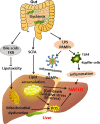Chinese Medicinal Herbs Targeting the Gut-Liver Axis and Adipose Tissue-Liver Axis for Non-Alcoholic Fatty Liver Disease Treatments: The Ancient Wisdom and Modern Science
- PMID: 33101207
- PMCID: PMC7556113
- DOI: 10.3389/fendo.2020.572729
Chinese Medicinal Herbs Targeting the Gut-Liver Axis and Adipose Tissue-Liver Axis for Non-Alcoholic Fatty Liver Disease Treatments: The Ancient Wisdom and Modern Science
Abstract
Non-alcoholic fatty liver disease (NAFLD) is one of the most common chronic liver diseases worldwide. The pathogenesis of NAFLD is complex. Frontline western medicines only ameliorate the symptoms of NAFLD. On the contrary, the uniqueness of Chinese medicine in its interpretation of NAFLD and the holistic therapeutic approach lead to a promising therapeutic efficacy. Recent studies reveal that the gut-liver axis and adipose tissue-liver axis play important roles in the development of NAFLD. Interestingly, with advanced technology, many herbal formulae are found to target the gut-liver axis and adipose tissue-liver axis and resolve the inflammation in NAFLD. This is the first review summarizes the current findings on the Chinese herbal formulae that target the two axes in NAFLD treatment. This review not only demonstrates how the ancient wisdom of Chinese medicine is being interpreted by modern pharmacological studies, but also provides valuable information for the further development of the herbal-based treatment for NAFLD.
Keywords: Chinese medicinal herbs; adipose tissue–liver axis; gut–liver axis; non-alcoholic fatty liver disease; pathogenesis.
Copyright © 2020 Zhang, Wong, Tang, Kwan and Su.
Figures





Similar articles
-
Zexie-Baizhu Decoction ameliorates non-alcoholic fatty liver disease through gut-adipose tissue crosstalk.J Ethnopharmacol. 2025 Jan 30;337(Pt 1):118700. doi: 10.1016/j.jep.2024.118700. Epub 2024 Aug 23. J Ethnopharmacol. 2025. PMID: 39182702
-
Si Miao Formula attenuates non-alcoholic fatty liver disease by modulating hepatic lipid metabolism and gut microbiota.Phytomedicine. 2021 May;85:153544. doi: 10.1016/j.phymed.2021.153544. Epub 2021 Mar 10. Phytomedicine. 2021. PMID: 33773192
-
Multi-targeting therapeutic mechanisms of the Chinese herbal medicine QHD in the treatment of non-alcoholic fatty liver disease.Oncotarget. 2017 Apr 25;8(17):27820-27838. doi: 10.18632/oncotarget.15482. Oncotarget. 2017. PMID: 28416740 Free PMC article.
-
Targeting regulation of lipid metabolism with polysaccharide of traditional Chinese medicine for the treatment of non-alcoholic fatty liver disease: A review.Int J Biol Macromol. 2025 May;306(Pt 3):141660. doi: 10.1016/j.ijbiomac.2025.141660. Epub 2025 Mar 1. Int J Biol Macromol. 2025. PMID: 40032085 Review.
-
Traditional Chinese herbal extracts inducing autophagy as a novel approach in therapy of nonalcoholic fatty liver disease.World J Gastroenterol. 2017 Mar 21;23(11):1964-1973. doi: 10.3748/wjg.v23.i11.1964. World J Gastroenterol. 2017. PMID: 28373762 Free PMC article. Review.
Cited by
-
Jiang Zhi Granule protects immunological barrier of intestinal mucosa in rats with non-alcoholic steatohepatitis.Pharm Biol. 2021 Dec;59(1):1359-1368. doi: 10.1080/13880209.2021.1979594. Pharm Biol. 2021. PMID: 34915801 Free PMC article.
-
Mechanism of Huo-Xue-Qu-Yu Formula in Treating Nonalcoholic Hepatic Steatosis by Regulating Lipid Metabolism and Oxidative Stress in Rats.Evid Based Complement Alternat Med. 2021 Apr 29;2021:6026319. doi: 10.1155/2021/6026319. eCollection 2021. Evid Based Complement Alternat Med. 2021. PMID: 34007294 Free PMC article.
-
Phytonanotherapy for the Treatment of Metabolic Dysfunction-Associated Steatotic Liver Disease.Int J Mol Sci. 2024 May 21;25(11):5571. doi: 10.3390/ijms25115571. Int J Mol Sci. 2024. PMID: 38891759 Free PMC article. Review.
-
Autophagy Blockade by Ai Du Qing Formula Promotes Chemosensitivity of Breast Cancer Stem Cells Via GRP78/β-Catenin/ABCG2 Axis.Front Pharmacol. 2021 Jun 3;12:659297. doi: 10.3389/fphar.2021.659297. eCollection 2021. Front Pharmacol. 2021. PMID: 34149413 Free PMC article.
-
The gut-liver axis in fatty liver disease: role played by natural products.Front Pharmacol. 2024 Apr 15;15:1365294. doi: 10.3389/fphar.2024.1365294. eCollection 2024. Front Pharmacol. 2024. PMID: 38686320 Free PMC article. Review.
References
-
- Vilar-Gomez E, Calzadilla-Bertot L, Wong VW-S, Castellanos M, Aller-de la Fuente R, Metwally M, et al. Fibrosis severity as a determinant of cause-specific mortality in patients with advanced nonalcoholic fatty liver disease: a multi-national cohort study. Gastroenterology (2018) 155:443–57. 10.1053/j.gastro.2018.04.034 - DOI - PubMed
Publication types
MeSH terms
Substances
LinkOut - more resources
Full Text Sources
Medical

